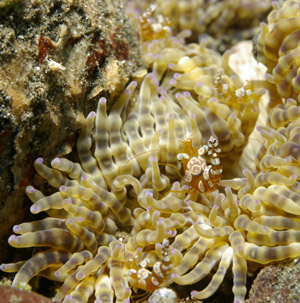Distant Cousins, But Close: The Surprising Complexity of The Sea Anemone Genome
24 Jul, 2007 12:32 pm
The question of what the common ancestor of multicellular animals looked like has puzzled biologists for a long time. With the genome of the starlet sea anemone in hand, we can estimate the genome of the common ancestor of 'true' multicellular animals, eumetazoans, and it is turning out to be surprisingly complex.
 The genome of the starlet sea anemone Nematostella vectensis, has been sequenced. Nematostella belongs to the phylum Cnidaria (a group of animals with a sac-like body plan) and stinging cells and lives in brackish water on the eastern and western coasts of the United States and the U.K. The body plan of this animal appears simple - a hollow tube with two cell layers in the body wall and with one opening (the mouth) which is surrounded by eight to twelve hollow tentacles. Putnam et al. find that the anemone genome contains about 18,000 genes, two-thirds of which can be traced back to the eumetazoan ancestor.
The genome of the starlet sea anemone Nematostella vectensis, has been sequenced. Nematostella belongs to the phylum Cnidaria (a group of animals with a sac-like body plan) and stinging cells and lives in brackish water on the eastern and western coasts of the United States and the U.K. The body plan of this animal appears simple - a hollow tube with two cell layers in the body wall and with one opening (the mouth) which is surrounded by eight to twelve hollow tentacles. Putnam et al. find that the anemone genome contains about 18,000 genes, two-thirds of which can be traced back to the eumetazoan ancestor.By grouping related genes from the anemone and one or more of other animals such as flies, frogs, fish and humans, Putnam et al. find that the ancestral eumetazoan had at least 7700 gene families. About a quarter of these gene families are found in anemones and vertebrates, but not in fruit flies and nematodes. This suggests that these two species have lost a lot of the genes that were present in their ancestor or that the sequences of the genes they inherited from the ancestor have diverged greatly from the original versions.
When Putnam et al. use related genes found in all species in their analysis to make a 'tree' that represents the relationships of these species, they find that though flies and nematodes emerge as closer cousins of humans than anemones, the genes in flies and nematodes have accumulated more changes over time. A comparison of introns, the intervening parts of DNA in a gene that don't contribute to the protein, also shows that anemones have retained more of the ancestral introns than flies or nematodes (round worms) have.
The theme of greater similarity of the anemone genome to the human genome than either the fly and nematode genomes emerges again in a comparison of the locations of related genes between human and Nematostella. Putnam et al. find that genes that are grouped close together in the human genome are also close together in the anemone genome, though not in the same order. The human segments and Nematostella scaffolds that have a significant number of related genes in them are called Putative Ancestral Linkage Groups, or PALs. These PALs might represent chunks of the eumetazoan ancestor's genome that got broken up in different ways in Nematostella and in human but still managed to retain the same genes from the ancestor.
Having reconstructed the genome of the eumetazoan ancestor in this manner, Putnam and his colleagues sought to understand how the genes of this ancestor evolved. Of the 7700 ancestral genes, nearly 80% are related to genes in other organisms such as fungi and plants and therefore, were probably present in the ancestor of all eukaryotes (organisms with nucleated cells). The remaining genes appears to be specially eumetazoan - they evolved somewhere along the lineage leading to the ancestor of cnidarians, flies and humans, but after the lineage separated from other major eukaryotic groups. 15% of the ancestral eumetazoan genes appear to be completely novel - no other organisms have genes related to these; 2% have a novel domain of sequence added to previously existing genes; 3% have domains of DNA sequences that are found in other eukaryotes in new combinations.
These insights into the origins of genes can be applied to biological processes that are the hallmark of multicellular animals, metazoans, to see how they came to be. Cells in metazoans stick to each other and communicate with each other to coordinate the activities of the entire organism. Nematostella, with its 'simple' body plan, has all the essential molecular components of these metazoan pathways represented in its genome. We find that these pathways evolved by the decoration of old eukaryotic cascades with new inputs and mediators. These new proteins came to exist in one of the three ways described above before cnidarians evolved, about 600 million years ago.
The sequencing of the Nematostella genome has given insight into a complex ancestor of multicellular animals. The forthcoming genomes of other early metazoans will extend our understanding of the events that shaped the genomes of multicellular animals. These genomes will not only help us draw a picture of the ancestral genome, but also aid in experiments that can tell us about the functions of genes during metazoan evolution. The discovery that animals that look as different as humans and anemones do have very similar genomes suggests that other processes such as how these genes interact with each other or how they are regulated may help explain the differences between different animal groups.
Reference:
Nicholas H. Putnam, et al, Sea Anemone Genome Reveals Ancestral Eumetazoan Gene Repertoire and Genomic Organization, Science 6 July 2007: Vol. 317.






